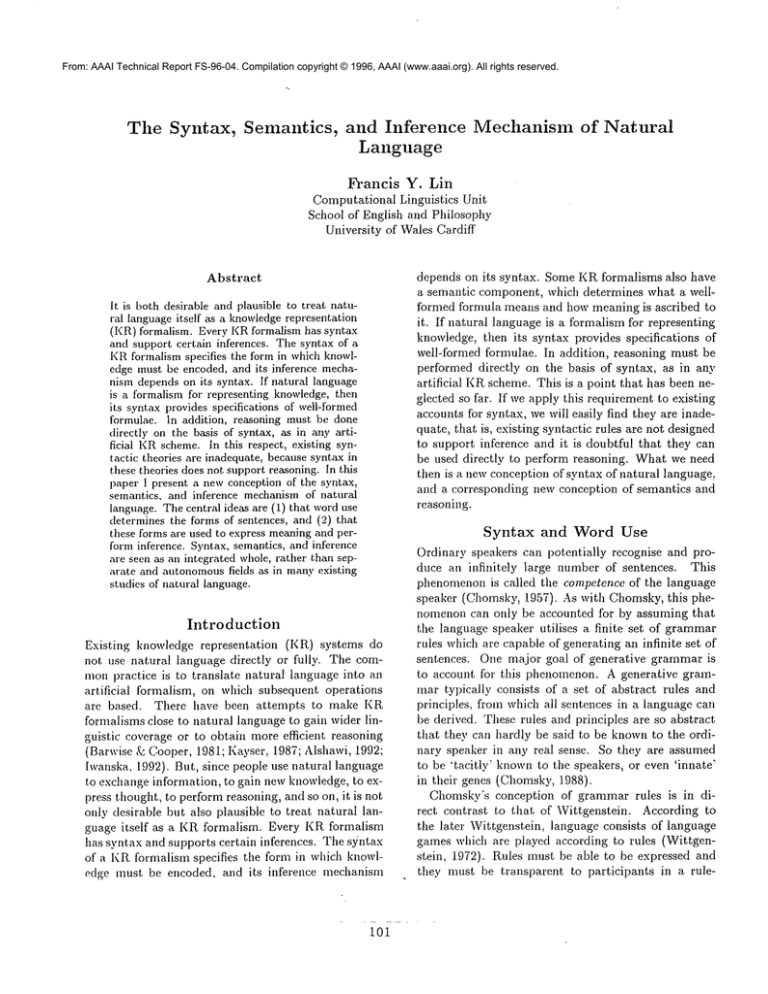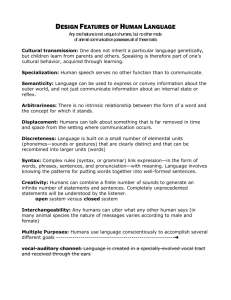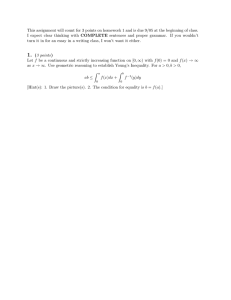
From: AAAI Technical Report FS-96-04. Compilation copyright © 1996, AAAI (www.aaai.org). All rights reserved.
The Syntax,
Semantics,
and Inference
Language
Mechanism of Natural
Francis
Y. Lin
Computational Linguistics Unit
School of English and Philosophy
University of ~¥ales Cardiff
depends on its syntax. Some KRformalisms also have
a semantic component, which determines what a wellformed formula means and how meaning is ascribed to
it. If natural language is a formalism for representing
knowledge, then its syntax provides specifications of
well-formed formulae. In addition, reasoning must be
performed directly on the basis of syntax, as in any
artificial KRscheme. This is a point that has been neglected so far. If we apply this requirement to existing
accounts for syntax, we will easily find they are inadequate, that is, existing syntactic rules are not designed
to support inference and it is doubtful that they can
be used directly to perform reasoning. What we need
then is a new conception of syntax of natural language,
and a corresponding new conception of semantics and
reasoning.
Abstract
It is both desirable and plausible to treat natural languageitself as a "knowledgerepresentation
(KR) formalism. Every KRformalism has syntax
and support certain inferences. The syntax of a
KRformalism specifies the form in which knowledge must be encoded, and its inference mechanism depends on its syntax. If natural language
is a formalism for representing knowledge,then
its syntax provides specifications of well-formed
formulae. In addition, reasoning must be done
directly on the basis of syntax, as in any artificial KRscheme. In this respect, existing syntactic theories are inadequate, because syntax in
these theories does not support reasoning. In this
paper I present a new conception of the syntax,
semantics, and inference mechanismof natural
language. The central ideas are (1) that worduse
determines the forms of sentences, and (2) that
these forms are used to express meaningand perform inference. Syntax, semantics, and inference
are seen as an integrated whole, rather than separate and autonomousfields as in manyexisting
studies of natural language.
Syntax
Introduction
Existing knowledge representation
(KR) systems
not use natural language directly or fully. The commonpractice is to translate natural language into an
artificial
formalism, on which subsequent operations
arc based. There have been attempts to make KR
formalisms close to natural language to gain wider linguistic coverage or to obtain more efficient reasoning
(Barwise L: Cooper, 1981; Kayser, 1987; Alshawi, 1992;
Iwanska, 1992). But, since people use natural language
to exchange information, to gain new knowledge, to express thought, to perform reasoning, and so on, it is not
only desirable but also plausible to treat natural language itself as a KRformalism. Every KRformalism
has syntax and supports certain inferences. The s3/ntax
of a KRformalism specifies the form in which knowledge must be encoded, and its inference mechanism
i01
and
Word
Use
Ordinary speakers can potentially recognise and produce an infinitely
large number of sentences. This
phenomenon is called the competence of the language
speaker (Chomsky, 1957). As with Chomsky, this phenomenon can only be accounted for by assuming that
the language speaker utilises a finite set of grammar
rules which are capable of generating an infinite set of
sentences. One major goal of generative grammar is
to account for this phenomenon. A generative grammar typically consists of a set. of abstract rules and
principles, from which all sentences in a language can
be derived. These rules and principles are so abstract
that they can hardly be said to be knownto the ordinary speaker in any real sense. So they are assumed
to be ’tacitly ~ knownto the speakers, or even ’innate"
in their genes (Chomsky, 1988).
Chomsky’s conception of grammar rules is in direct contrast to that of Wittgenstein. According to
the later Wittgenstein, language consists of language
games which are played according to rules (Wittgenstein, 1972). Rules must be able to be expressed and
they must be transparent to participants in a rule-
governed practice (Baker &: Hacker, 1985, pp. 62-3).
In this section I outline an account of grammarwhose
rules are actually knownto the speakers. I shall start
with the notion of sentence structure and try to explicate the notion of grammar via some examples.
Consider the following sentence:
(1) John kissed Mary in front of Peter oll purpose,
because he wanted to annoy him.
The structure of the sentence, in myanalysis, is:
(2) somethingx happened because
something
v
1happened
where somethingx happened refers to:
2(3) John kissed Mary in front of Peter on purpose.
This sentence in turn has a structure, which is:
(4) somebody did something on purpose.
where somebody is John, somebody did something is:
(5) John kissed Mary in front of Peter.
The structure of sentence (5) is:
(6)
v. solnebodyx did something in front of somebody
where somebody~ did something refers to:
(7) John kissed Mary.
whose structure is:
(8) somebody~ kissed somebody
v.
It can be seen froln the above example that what I
call structures are expressions of word use. For exampie, (2, 4, 6, and 8) show how the words (and phrases)
’because’, ’on purpose’, ’in front of’, and ’kiss’ are used;
and one only needs a little reflection to confirm that
this is the case. I shall therefore call a structure like (2)
a usax, 3 and say that a word is used grammatically if it
conformsto its usax (or one of its usaxes if it has more
than one). Wecan now have a better idea about the
notions of sentence structure and can appreciate the
equivalence relationship between the following propositions:
(9) A string of words is a sentence.
(10) The string of words has a sentence structure.
(11) The sentence is gralnmatical.
(12) All the words have been used grammatically.
A few other examples may help to clarify the notions of structure, usax, and grammaticality. (13)
a grammatical sentence, it conforms to the structure
(15), which is a usax for ’kind’. (14) is ungralnmatical,
because there is no such usax as (16):
(13) It’s kind of you to come to see me.
(14) *It’s hungry of you to come to see me.
11 use somebodyx
to meanthat there is an entity x which
is referred to by the word ’somebody’.The referents will
be left out whenthere are no ambiguities present.
2For simplicity the analysis of the second half of (1),
which is ’he wantedto annoyhim’, will be omitted here.
3This notion is employedto stress the relationship between the use of words and the syntax of sentences.
102
(15) It’s kind of somebody to do something.
(16) *It’s hungry of somebodyto do something.
It is easy to see that usaxes, as those illustrated, are
general w~vs of how words are used and that they are
finite in number. Usaxes are grammarrules, according
to which we recognise sentences and determine their
grammaticality. We have learned them, and they are
knownto us. In the rest of this section I shall show
how this finite number of explicit grammar rules can
generate an infinite number of sentences.
Usaxes are concrete, in the sense that they are expressible in natural language. On the other hand they
are also general. The more general a usax is the more
sentences it can cover, that is, it can generate. For
example, there exists an increasing order of generality
amongthe following sentences:
(5) < (6) < (17) < (18)
where (17-19) are:
(17) Somebodydid something.
(18) Something happened.
(19) Somethingis the case.
(19) covers events, states, properties, and whatever you
have. In fact (19) is the most general form of sentences
(or usaxes).
The process of generalisation starts, as illustrated
above, from any sentence and ends in the most general form, which is (19). What is the converse process? It is an easy matter to see that it is generation,
in the Chomskyan sense. For example, one can begin with (19), through (18), (17), and (6),
with (5). 4 Notice that each general usax can generate
a large number of usaxes which are less general: and
the latter are capable of generating a great manyeven
less general usaxes. Note also that each least general
usax can still generate a large numberof concrete sentences. Through this process a grammar can generate
very many sentences. To ensure that a grammar can
generate an infinite numberof sentences, recursion will
have to be build into it. But I shall say no more about
this here.
To sum up, usaxes are grammarrules, they are finite
and are knownto the speakers. Through the process of
generalisation, one gets more and more general usaxes
and through the converse process, which is generation,
one produces (or can produce) all the sentences in
language.
4But one does not need to always start from (19)
generate a sentence. One can start from anywherein the
chain of generation. Note also that one does not ahvays
need to reach the end of the generation process either. One
can stop in the midway,to arrive at certain sentences: e.g.
(17).
Semantics
and
Inference
Semantics is the study of meaning. My aims in this
section are to present my view on meaning, and to
provide justification for it. I shall show that the theory developed here subsumes several major semantic
theories.
Wittgenstein rejects the idea that meaning is something abstract., something like a ’shadow’ of words and
sentences (Wittgenstein, 1972, PP. 117&120). He says
that to know tlle meaning of a word/sentence we must
look at how it is used and in what situation it is
used (Wittgenstein,
1972, PP. 43&592). Tile meaning of a word/sentence is the explanation we give (in
each of the concrete situation in which it is used). In
Wittgenstein’s words, ’meaning is what an explanation
of meaning explains’ (Wittgenstein, 1974, p. 69). Now,
how is explanation done? As one cannot, simply memorise all sentences (in order to recognise or produce
them), one cannot simply memorise the meaning of all
sentences (in order to explain the meaning}. To know
the meaning of a sentence, which is one of a potentially
infinite set, we inust perform some inferences.
I submit that tile meaning of a word/sentence is
the set of sentences which can be inferred from the
word/sentence, and I shall also call the latter the
meaning-bearing sentences of the former. By inference
(or reasoning) I mean not only formal inference (e.g.
deduction), but also inforlnal or practical reasoning
(e.g. speech acts), and inference of other sorts. Thus
semantics in the present framework is compatible with
Lyons’ linguistic semantics (Lyons, 1995). According
to this conception, there is no meaning in isolation:
meaning arises from interconnections (Strawson, 1992;
Quine & Ulian, 1978).
One influential semantic theory is based on semantic
primitives (I<atz, 1972; Jackendoff, 1976). There are
well-known problems with such an approach, such as
that it is difficult, or even impossible, to identiR’ the
primitive elements, and that ill tile vast majority of
cases such reductions are inadequate as full specification of meaning. As Lyons (Lyons, 1995) points out,
componential analysis based on semantic primitives
can be replaced by tile use of meaning-postulates. In
general, the semantic primitives of a word/sentence are
at best equivalent to a subset of its meaning-bearing
sentences.
It is also commonpractice to speciR, the meaning of
a sentence by assigning cases or participant roles for
the objects mentioned in the sentence, e.g. (Filhnore,
1968: Halliday, 1994). For example, in ’John kissed
Mary’ "John’ is said to be the agent, ’Mary" the patient. There are often difficulties in determining how
manyroles there are and what they are, and in assign-
103
ing roles to objects mentioned in a sentence. Another
problem is that roles are usually not capable of capturing enough, let alone complete, meaning. Consider
’John dried the shirt’ for instance, the roles can not
capture the meaning such as ’the shirt was wet and
it is now dry’. Viewed from the vantage point of the
current theory, roles are merely short-form for some (a
subset) of the meaning-bearing sentences, e.g. ’John
did the kissing’, ’Mary was kissed’. Thus, in a certain
sense role-based theories can be seen as a simplified
version of the present theory, in which only certain
types of inference are in operation (see next section).
A third major semantic theory utilises the notion
of truth conditions, the most important version being
Davidson’s. Davidson explicates the meaning of a sentence in terms of its truth conditions, conditions under which the sentence is true (Davidson, 1967, 1970).
As Dmnmett (1976) points out, the theory does not
explain how the speaker can know those truth conditions. It also implies that the ordinary speaker masters
the predicate-calculus and the translation rules which
paraphrases the ordinary sentences into their Davidsonian replacements, which is both ’unrealistic’
and
’unnecessary’ (Strawson, 1992, p. 103). It is not difficult to see that, like the roles-based theories, the truth
conditions of a sentence are a subset of its meaningbearing sentences.
Moravcsik (1990) contends that ’the meaning of
word "w" is that in virtue of which an element of reality counts as a w’. For example, the meaning of ’water’ is that it is a clear, odourless liquid, and is used
for drinking, and irrigation, etc. The present account
largely agrees with Moravcsik’s view of meaning. What
he regards as tile meaning of a word is effectively the
set of sentences we can infer from the word. These
meaning-bearing sentences are what we know about
(or infer from) the word, and hence are its meaning.
Moravcsik’s theory is only about words, and he has
not yet touched upon the meaning of sentences, which
is an equally, and probably more important part of a
theory of meaning. The account presented here has
just done this. It is a natural extension of Moravcsik’s
work, for either the meaning of a word or that of a
sentence is the set of its meaning-bearing sentences,
thus they can be, as they are in the present framework.
treated in the same way.
So far I have examined four major senrantic theories. These theories appear to be diverse, but from the
present point of view they are actually closely related,
and they can all be subsumed in the present theory.
The meaning of a word/sentence in these theories is
part of what it is in the present framework. These
theorists attempt to impose certain constraints on in-
ference, though they may be unaware of this. In other
words, the theories I have just studied only employ
certain types of inference.
Inference
in Natural
Language
Having established that the meaning of a sentence is
the set of sentences which can be inferred from it, the
task of semantics then becomes the task of explaining
how inference is done. In parallel to the conception
of grammar presented in Section 2 I shall provide an
account for semantics based on a finite number of inference rules which are knownto the speakers
Inference of meaning can take manyforms (or types),
four of which will be discussed here. I shall first explicate what the four types of inference are by giving
examples, and then briefly compare lny treatment of
them with solne other approaches. The most common
type of meaning inference is performed through the
meaning of words (and phrases), which speakers are
aware of and are able to explain. Manynew words are
learned also in this way, i.e. through their explanation
in terms of other words (Johnson-Laird. 1983, oh. 10).
For example, we know:
(20) If you do something on purpose, you do it deliberately.
(21) If you do somethixlg in front of somebody, you
do it when he is present.
(22) If you kiss somebody, you touch him with your
lips.
I shall call sentences like (20-22) meaningelucidations,
following (Higginbotham, 1989). 5 It is readily seen
that meaning elucidations also have a structure (e.g.
If x then y), which consists of structures of the constituent sentences (compare (20-22) with (4, 6, 8)).
we apply the meaning elucidations (20-22) to sentences
(4, 6, 8) respectively, then we should be able to infer
the corresponding sentences. I shall use the term elucidation to refer to this type of inference.
Another commonway of explaining the meaning of
a sentence is to use its equivalent or near-equivalent
sentences. For example, (23) is equivalent to (24),
(25) meanstile saine as (26):
(23) You gave something to somebody.
(24) You gave somebody something.
5This is not to advocate a ’dictionary’ view of meaning,
which implies that meaningis fixed. Accordingto Wittgenstein (Wittgenstein, 1972, P. 456), if somebody
just said
kissed Mary"and I nowsimply mimichis voice and also say
’I kissed Mary’,then I didn’t really kiss Mary(i.e. touch her
with mylips). But this is due to the meaningof the word
’inimic’. It. is true that the meaningof words/sentencesdepends on the situations in whichthey are used, but we must
knowthe meaning of the words/sentences which describe
such situations and perform corresponding inference.
104
u(25) There is something, in something
(26) Somethingv has something, in it.
I shall call equivalent sentences such as (23-26) meaning equivalences. This type of inference will be called
equivalisation.
The third type of commonlyused inference is deletion, which basically means that we can infer from
some sentences some of their parts. The following sentence is a deletion rule:
(27) If you did something at a certain time, in
certain place, in a certain way, or for a certain reason.
etc., then you did it.
The fourth type of inference is what I shall call exposition. It is used to expose the semantic roles (sometimes called case roles or participant roles) in sentences. Below are a few examples of exposition rules:
(28) If x did y, then what x did is to do
(29) If x did y, then what (or the person who)
yisx.
(30) Ifx did y to z, then what (or/the person whom)
x did y to is z.
It is easy to see that all these four types of inference
are based on usaxes: Given any sentence, we can abstract its usax. This usax will match one (or more)
semantic rules, and corresponding inferences will be
obtained. It is here that grammar elucidated in Section 2 and semantics discussed in this section come to
contact with each other, and the interaction is very
smooth.
It is also here that we see more clearly the relationships between my account of meaning and other semantic theories. By using elucidation and equivalisation we
can replace theories based on semantic primitives. By
using exposition we can replace semantic roles. And
by using deletion we can replace at least the part of
Davidson’s theory which accounts for the derivation of
(32) from (31):
(31) John kissed Mary in front of Peter.
(32) John kissed Mary.
In doing so, we also avoid many fundamental problems
inherent in those theories, which were mentioned in the
previous section.
Conclusions
and Discussions
It is bot.h desirable and plausible to use natural language as a means of representing knowledge and performing reasoning. This requires that the syntax of
natural language should specify the format in which
knowledge is encoded, and that reasoning should operate directly on the basis of syntax as in any artificial
KR scheme. Existing accounts of syntax are inadequate, because the syntax developed so far is separate
from and cannot support reasoning. A new conception
of syntax, semantics, and reasoning is needed.
In this paper I presented a new way of looking at the
syntax, semantics and inference mechanism of natural
language. The basis of investigation is word use. In
learning a language we learn not only words, but also
how they are used and what they mean. The rules of
grammar, meaning, and inference are closely related to
word use and they are known to ordinary speakers. In
order to understand these notions I have taken necessary excursions into linguistics and philosophy. What
was achieved was a unified account for these notions.
As I argued, usaxes are grammar rules, they determine sentence recognition and generation. They are
the forms in which meaning is expressed, and reasoning is performed. Thus, syntax, semantics, and reasoning form an integrated whole, rather than separate
and autonomous components of natural language.
Further work is still needed to develop the present
account of language into a satisfying theory. One direction is to explain within this frameworkmore syntactic
phenomena,e.g. passivisation, reflexives, etc, as dealt
with in Government and Binding Theory (Haegeman,
1994). Another direction is to explore further the inference process based on usaxes (see Lin (1996)).
I am greatful to Sir Peter Strawson for discussions,
eon]ments, and encouragement. All errors are mine.
Reference
(1992). The Core English Engine.
Baker, G. P., & Itacker, P. M. S. (1985). Wittgenstein:
Rules. Grammarand Necessity. Blackwell, Oxford.
Barwise, J., & Cooper, R. (1981). Generalized quantitiers and natural language. Linguistics and PhiIosophy, 4, 159-219.
Chomsky, N. (1957). Syntactic
The Hague.
Fillmore, C. (1968). The case for case. In Bach, E.,
& Harms, R. T. (Eds.), Universals in Linguistic
Theory. Rinehart and Winston, NewYork.
Haegeman, L. (1994). Introduction to Government and
Binding Theory (2rid edition). Blackwell, Oxford.
Halliday, M. A. K. (1994). Introduction of Functional
Grammar (revised edition).
Edward Arnold,
London.
Higginbotham, J. (1989). Elucidations of meaning.
Linguistics and Philosophy, 12, 465-517.
Iwanska, L. (1992). A general semantic model of negation in naturM languages: representation and inference. In Proceedings of the Third Conference
on the Principles of Knowledge Representation
and Reasoning.
Jackendoff, R. (1976). Towards an explanatory semantic representation. Linguistic Inquiry, 7, 89-150.
Johnson-Laird, P. N. (1983). Mental ,l,lodels.
bridge University Press, Cambridge.
Acknowledgements
Alshawi, H. (Ed.).
MIT Press.
Dummett, M. (1976). What is a theory of meaning?
(ii). Reprinted in his The Seas of Language,
Clarendon Press, Oxford, 1993.
Structures.
Mouton,
Chomsky. N. (1988). Language and Problems
IO~owledge. The MIT Press, London.
of
Davidson, D. (1967). Truth and meaning. Reprinted
in his hlquiries into Truth and Interpretation,
Clarendon Press, Oxford, 1984.
Davidson. D. (1970). Semantics for natural languages.
Reprinted in his Inquiries into Truth and Interpretatiou. Clarendon Press. Oxford. 1984.
105
Katz, J. (1972).
New York.
Semantic Theory.
Cam-
Harper & Row,
Kayser, D. e. a. (1987). A strategy for reasoning
natural language. Applied Artificial Intelligence.
1, 205-231.
Liu, F. Y. (1996). On the notion of logical form. Computational Linguistics Unit, School of English
and Philosophy, University of Wales Cardiff.
Manuscript.
Lyons, J. (1995). Linguistic Semantics. Cambrige University Press, Cambridge.
Moravcsik, J. M. E. (1990). Thought and Language.
Routledge, London.
Quine, W. V. O., & Ulian, J. (1978). The Webof Belief
(rev. edition). RandomHouse, NewYork.
Strawson, P. F. (1992). Analysis and Metaphysics: An
Introduction to Philosophy. Oxford University
Press, Oxford.
Wittgenstein, L. (1972). Philosophical Investigations
(3rd edition). Blackwell, Oxfford.
Wittgenstein,
L. (1974). Philosophical
Blaekwell, Oxford. Rhees, R. (ed.).
Grammar.






